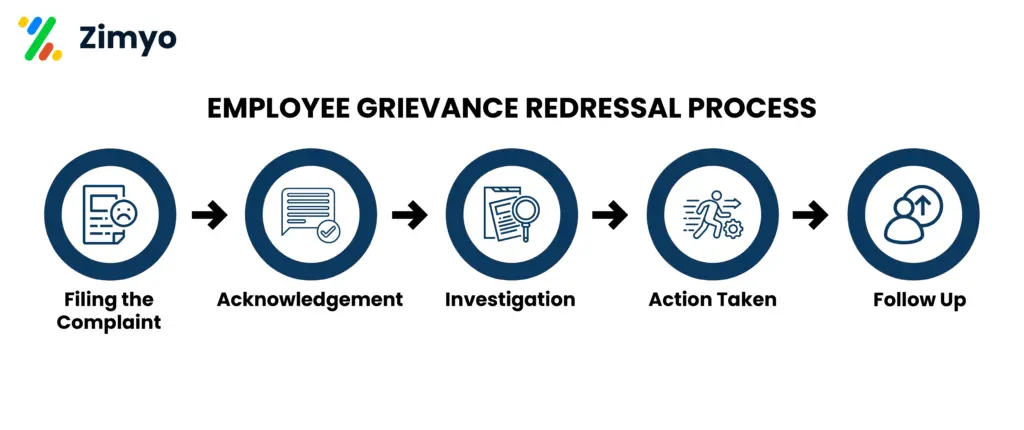In any workplace, it’s natural for employees to face issues. But when these issues turn into serious concerns that affect their morale or productivity, they are known as employee grievances. Understanding the employee grievance meaning is essential for building a healthy and fair work environment.
Let’s explore what employee grievances are, what causes them, how they can be addressed, and why every organization needs a proper grievance handling system.

What is Employee Grievance?
So, what is employee grievance? An employee grievance is a formal complaint raised by an employee about unfair treatment, work conditions, company policies, or any issue that affects their well-being at work. It can be verbal or written and may involve anything from harassment and discrimination to unsafe workspaces or unequal pay.
Employee grievances might be reasonable or unjustified. They must, however, be effectively addressed by the leadership team since they impact not just the employee’s productivity and commitment but also the work environment. If left unaddressed, employee issues might develop into major internal conflicts. Other employees’ motivation may suffer as a result.
Employee Grievance Meaning in Simple Words
The employee grievance meaning refers to an employee’s dissatisfaction or discomfort that arises due to workplace practices, management decisions, or co-worker behavior. These grievances, if ignored, can lead to employee demotivation, reduced performance, or even resignations.
In simple terms, it’s how an employee expresses that something is not right at their job.
Handling Employee Grievances
- Make it clear to employees that they are free to express their concerns. Establish a grievance policy that is available to all workers. Make sure they know who to contact and that their information is kept private. Most essential, establish a deadline for resolving the complaints.
- An essential thing to do when someone has a problem is to make them feel heard. Although the remedy may not be practical, it is vital to inform them that the problem will be resolved in a fair, transparent, and timely manner.
- It is critical to forming an investigative committee to handle the employee’s complaints. Inquire about the situation, if required, speak with other employees, and allow them time to offer evidence for their accusations.
What are the types of grievances in workplace?
Some of the most common types of grievances in a workplace are:
1. Pay and Benefits
These kind of grievances arises when the salary of an employee is inadequate according to his expectation.
2. Bullying of employee or staff member
Workplace bullying or harassment cases are now seen in workplace where the laws are weak
3. Work conditions of the organization
It includes cleanliness of workplace, sanitary facilities etc.
4. Workload on an employee
If an employee is overburdened with workload such kind of grievances arises in the organization
Common Causes of Employee Grievance
Understanding the employee grievance causes is important for addressal and to prevent them. Some common reasons include:
- Unfair Treatment – Bias in promotions, transfers, or opportunities.
- Poor Working Conditions – Lack of safety, hygiene, or proper equipment.
- Discrimination – Based on gender, race, age, religion, etc.
- Salary Issues – Delayed payments or unequal pay for the same work.
- Lack of Communication – Feeling unheard or uninformed about workplace matters.
- Bullying or Harassment – Inappropriate behavior from colleagues or superiors.
Examples of Employee Grievance
Here are some real-world employee grievance examples to understand how they show up in workplaces:
Example 1. An employee is passed over for a promotion despite meeting all targets, while a less experienced colleague is promoted.
Example 2. Workers are not provided with safety gear in a manufacturing unit.
Example 3. A female employee faces inappropriate comments from a team member.
Example 4. Employees are not paid overtime despite working extra hours.
Check Out Our Blog on POSH Act.

Employee Grievance Redressal Process
Handling grievances quickly and fairly is important for protecting employees growth and interest and for the performance of an organization. The employee grievance redressal process ensures that issues are addressed before they become bigger problems.
Here is a simple 5-step redressal process:
- Filing the Complaint – The employee submits the complaint to the HR department or manager.
- Acknowledgement – The complaint is received and acknowledged formally.
- Investigation – A thorough review of the issue is conducted, including talking to both parties.
- Action Taken – Appropriate corrective action is taken based on the findings.
- Follow-Up – HR checks in with the employee to ensure the problem is resolved.
Importance of Employee Grievance Policy
A clear and fair employee grievance policy helps organizations manage employee concerns efficiently. This policy should include:
- How to raise a grievance
- Expected timeline for action
- Confidentiality assurance
- No retaliation clause
Such policies show employees that their voice matters and problems will be addressed with care.
Role of Employee Grievance in HRM
In Human Resource Management (HRM), handling grievances is a key function. Employee grievance in HRM focuses on:
- Protecting employee rights
- Ensuring fairness
- Promoting trust between staff and management
- Avoiding legal issues
By managing grievances well, HR can help improve workplace harmony and job satisfaction.
What is an Employee Grievance Portal?
A modern tool many companies use is an employee grievance portal. It is an online platform where employees can:
- Submit complaints easily and anonymously
- Track the status of their grievance
- Access company policies and rights
- Communicate with HR securely
It helps streamline the grievance redressal process and builds transparency and trust.
Conclusion
Now that you know the employee grievance meaning, it’s clear why organizations must take them seriously. Whether it’s about unfair practices or poor communication, addressing grievances fairly creates a culture of openness and respect.
A well-planned employee grievance redressal process, supported by HR and digital tools like an employee grievance portal, can boost morale, reduce turnover, and protect your company’s reputation.
FAQs:
What does employee grievance mean?
It refers to a complaint raised by an employee regarding unfair treatment, work conditions, or any workplace issue.
What are common causes of employee grievances?
Grievances often arise due to discrimination, pay issues, unfair treatment, poor working conditions, or harassment.
How can employee grievances be addressed?
Through a formal redressal process involving complaint submission, investigation, resolution, and follow-up.
Why is grievance redressal important in HRM?
It helps maintain employee trust, avoids conflicts, and ensures legal and ethical practices in the workplace.
